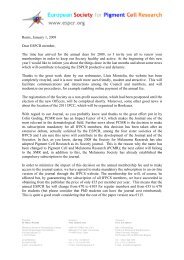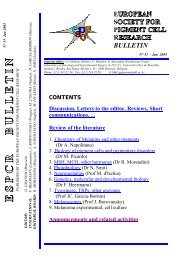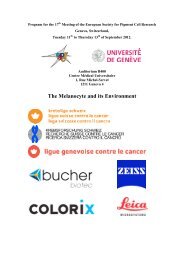espcrbulletin - European Society for Pigment Cell Research
espcrbulletin - European Society for Pigment Cell Research
espcrbulletin - European Society for Pigment Cell Research
Create successful ePaper yourself
Turn your PDF publications into a flip-book with our unique Google optimized e-Paper software.
compounds, TGH11, TGD10, TGD39 and TGJ29, as potent pigmentation inhibitors with IC(50)<br />
values in the range of 10 muM. These newly identified depigmenting compounds were found to<br />
function as reversible inhibitors of tyrosinase, the key enzyme involved in melanin synthesis.<br />
Tyrosinase was further confirmed as the cellular target of these compounds by affinity<br />
chromatography. Kinetic data suggest that all four compounds act as competitive inhibitors of<br />
tyrosinase, most likely competing with l-3,4-dihydroxyphenylalanine (l-DOPA) <strong>for</strong> binding to the<br />
DOPA-binding site of the enzyme. No effect on levels of tyrosinase protein, processing or<br />
trafficking was observed upon treatment of melanocytes with these compounds. Cytotoxicity was<br />
not observed with these compounds at concentrations up to 20 muM. Our data suggest that<br />
TGH11, TGD10, TGD39 and TGJ29 are novel potent tyrosinase inhibitors with potential<br />
beneficial effects in the treatment of cutaneous hyperpigmentation.<br />
- Ni-Komatsu L, Orlow SJ.<br />
Heterologous expression of tyrosinase recapitulates the misprocessing and mistrafficking in<br />
oculocutaneous albinism type 2: Effects of altering intracellular pH and pink-eyed dilution<br />
gene expression. Exp Eye Res. 2005 Sep 29; [Epub ahead of print]<br />
The processing and trafficking of tyrosinase, a melanosomal protein essential <strong>for</strong> pigmentation,<br />
was investigated in a human epithelial 293 cell line that stably expresses the protein. The effects of<br />
the pink-eyed dilution (p) gene product, in which mutations result in oculocutaneous albinism type<br />
2 (OCA2), on the processing and trafficking of tyrosinase in this cell line were studied. The<br />
majority of tyrosinase was retained in the endoplasmic reticulum-Golgi intermediate compartment<br />
and the early Golgi compartment in the 293 cells expressing the protein. Coexpression of p could<br />
partially correct the mistrafficking of tyrosinase in 293 cells. Tyrosinase was targeted to the late<br />
endosomal and lysosomal compartments after treatment of the cells with compounds that correct<br />
the tyrosinase mistrafficking in albino melanocytes, most likely through altering intracellular pH,<br />
while the substrate tyrosine had no effect on the processing of tyrosinase. Remarkably, this<br />
heterologous expression system recapitulates the defective processing and mistrafficking of<br />
tyrosinase observed in OCA2 albino melanocytes and certain amelanotic melanoma cells.<br />
Coexpression of other melanosomal proteins in this heterologous system may further aid our<br />
understanding of the details of normal and pathologic processing of melanosomal proteins.<br />
- Obata H, Ishida H, Hata Y, Kawato A, Abe Y, Akao T, Akita O, Ichishima E.<br />
Cloning of a novel tyrosinase-encoding gene (melB) from Aspergillus oryzae and its<br />
overexpression in solid-state culture (Rice Koji). J Biosci Bioeng. 97(6):400-5, 2004.<br />
We have cloned a novel tyrosinase-encoding gene (melB) specifically expressed in solid-state<br />
culture of Aspergillus oryzae. A tyrosinase-encoding gene (melO) from A. oryzae was already<br />
cloned and the protein structures of its catalytic and copper binding domains were investigated.<br />
However, our recent results revealed that the melO gene was highly expressed in submerged<br />
culture but not in solid-state culture. Because tyrosinase activity was also detected in solid-state<br />
culture, we assumed that another tyrosinase gene other than melO is expressed in solid-state<br />
culture. Another tyrosinase gene was screened using the expressed sequence tag (EST) library. One<br />
redundant cDNA clone homologous with the tyrosinase gene was found in the collection of wheat<br />
bran culture. Northern blot analysis revealed that the gene corresponding to the cDNA clone was<br />
specifically expressed in solid-state culture (koji making), but not in submerged culture. Molecular<br />
cloning showed that the gene carried six exons interrupted by five introns and had an open reading<br />
frame encoding 616 amino acid residues. This gene was designated as melB. The deduced amino<br />
acid sequence of the gene had weak homology (24%-33%) with MelO and other fungal tyrosinases<br />
but the sequences of the copper binding domains were highly conserved. When the melB gene was<br />
expressed under the control of the glaB promoter in solid-state culture, tyrosinase activity was<br />
markedly enhanced and the culture mass was browned with the melanization by MelB tyrosinase.<br />
These results indicated that the melB gene encodes a novel tyrosinase associated with melanization<br />
in solid-state culture.<br />
1445







